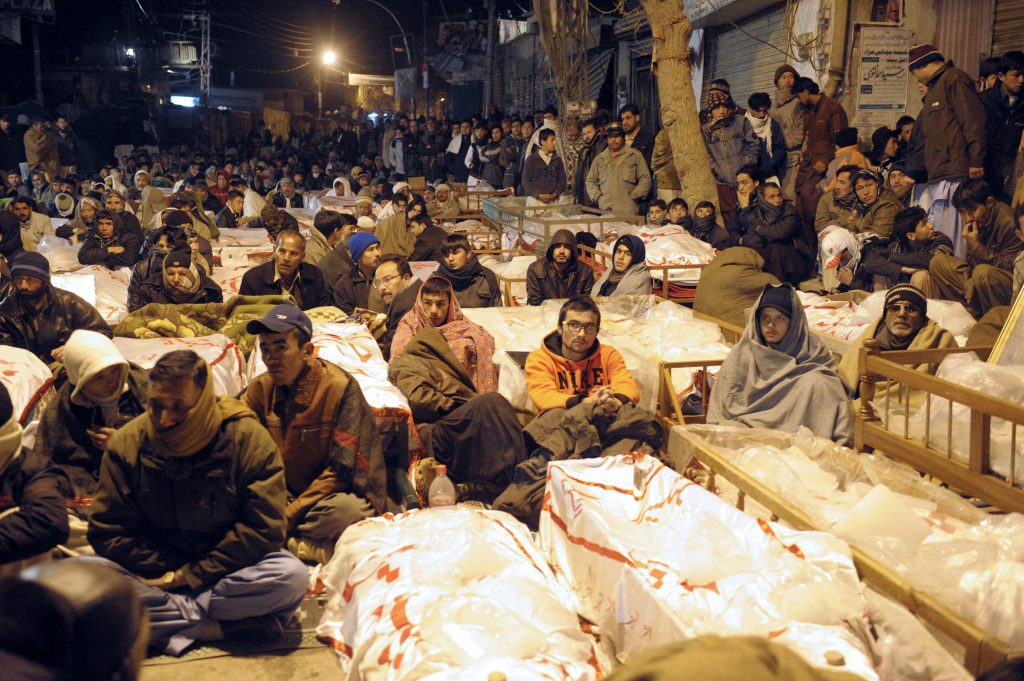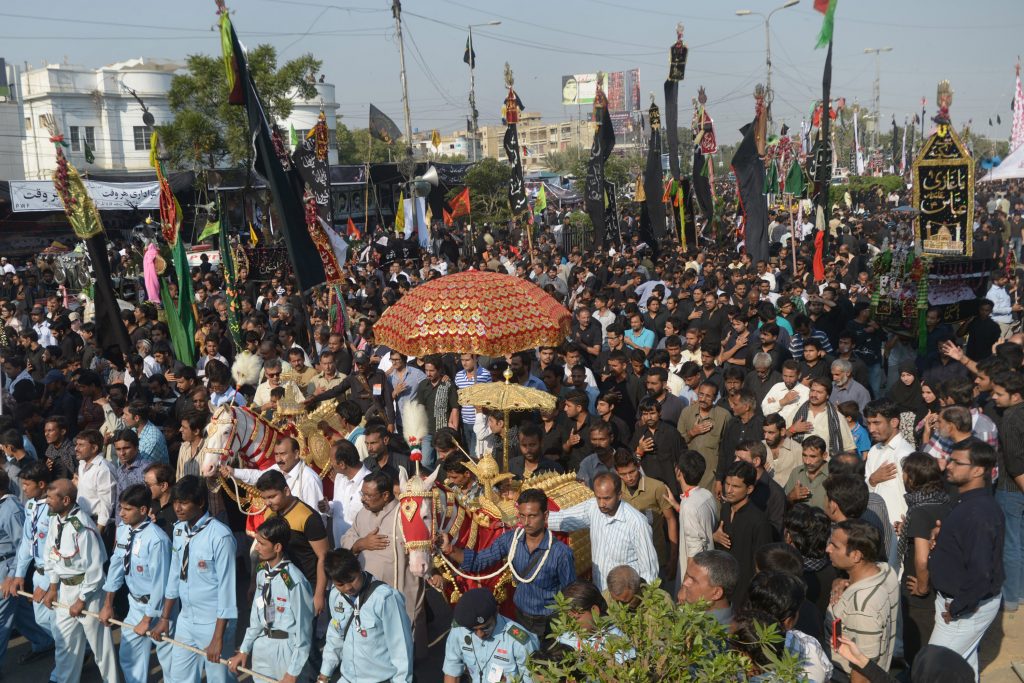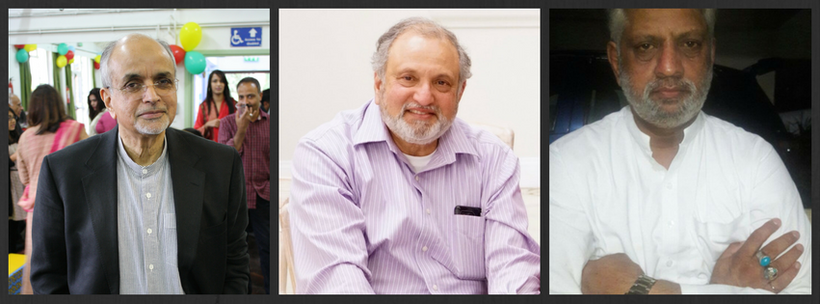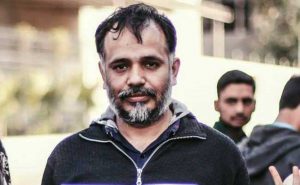One Way War
By Dr Hassan Auj | Newsbeat National | Special Report | Published 9 years ago
Each day one wakens to a news bulletin about the killing of random civilians. The reports are now so commonplace that they often go unnoticed. And the victims’ identities are usually obfuscated by the mainstream media. But a little bit of spadework helps unearth the facts. Most of the deceased are invariably Shia Muslims.
Muharram is the month that draws the Shias out on the streets to commemorate the sacrifice of the martyrs of Karbala. Not long ago, the head of the Ahle Sunnat Wal Jamaat (ASWJ), sectarian leader Maulana Ahmed Ludhianvi, issued a statement that his followers would desist from taking to the streets for rallies if the Shias stopped taking out their Muharram processions. The message: the most important ritual of the Shia faith has the same significance as a protest gathering by members of the proscribed ASWJ (as per the National Counter-Terrorism Authority list). The ASWJ’s presumption in making demands of such magnitude is not hard to understand. By law, the party is not allowed to gather anywhere in Pakistan since it is a banned organisation. Yet they continue to hold rallies whenever and wherever they want, with complete impunity. And they do so while chanting inflammatory sectarian slogans like ‘Shia kafir.’
But hate speech against them is just the first part of the Shia community’s travails. They have become victims of an ongoing bloodbath — and no Shia anywhere seems safe. On the 3rd of Muharram, four Hazara women in a bus in Quetta were identified as Shias. They were killed. Soon thereafter, two young Pashtun Shia men were targeted in Hasanabdal. On the 6th of Muharram, Mansoor Zaidi, a school principal and the trustee of an imambargah was killed, and his son Ammar Zaidi was critically injured right in front of their house, allegedly because they had secured a permit to hold a procession on 7th Muharram in Shah Faisal Colony, Karachi. The same night, two Shias, identified as Jawwad and Haider, were killed in Gulshan-e-Iqbal. And on the 12th of Muharram, dozens of Shias were injured during a mourning ritual in Kotli Laharana Mashriqui, Sialkot district. All the victims of these attacks were attacked for only one reason: their religious beliefs.
The ugly face of sectarianism first raised its head with the formation of the Sipah-e-Sahaba Pakistan (SSP) in 1985. To counter them was born the Sipah-e-Muhammad in 1994, which led to a series of killings that were extreme in nature and venomous in ideology. Banned by Pervez Musharraf in 2002, the Sipah-e-Muhammad ceased to exist soon after, but the SSP continued its hate campaign under a different name: the Ahle Sunnat Wal Jamaat. This group comprises clergy from the Deobandi school, but is not owned by the mainstream Deobandi sect. And thereafter began, in the words of slain civil society activist, Khurram Zaki, “a one-sided genocide.”
Being an increasingly vulnerable minority group, Shia Muslims have nowhere to plead their case. Many in Pakistan do not, in fact, even identify them as Muslims. Post the Iranian revolution, Shias in Pakistan increasingly began to be seen as a political entity rather than a religious sect. This theory was further strengthened by the formation of the Tehreek-e-Nifaz-e-Fiqah Jaffria, which was originally created in opposition to the anti-Shia laws promulgated by Zia-ul-Haq’s regime. The laws were repealed in 2002.
On October 29, 2016, the banned ASWJ conducted a rally in the heart of Karachi chanting ‘Shia kafir’ slogans. Five hours later, at a majlis of women being held in a house in Nazimabad, assailants, who later claimed to be from another sectarian organisation, the Laskar-e-Jhangvi (LeJ), killed five people, including three brothers and their uncle who happened to be on the premises. The siblings were identified as Baqar Abbas Zaidi, Nayyar Mehdi, Nasir Abbas Zaidi and their uncle, Syed Zaki Abbas. The brothers were visiting Pakistan from the US and UK respectively. Five others were injured in the attack. The killers were trying to get into the majlis but they were apprehended by the men who got shot while protecting the women.
The murders engendered a protest rally, which began at the Sindh Inspector General Police’s (IGP) office. Some protestors were arrested and later released. The protest then continued at the Press Club for 12 hours, with the protestors demanding the suspension of the police superintendent under whose policing jurisdiction the area where the attack had occurred lay. Finally, the IG Sindh, A.D. Khwaja, addressed a delegation of protestors, and agreed to take action after conducting an inquiry into the matter. He also asserted that in future any “takfeeri” (the act of declaring people apostates) or “anti-Shia” act would not be tolerated.
Meanwhile, on October 31, PPP Chairman Bilawal Bhutto commented that Chaudhry Nisar was silent when it came to the issue of terrorism, and added that the minister could instead be seen holding photo sessions with pro-Taliban individuals, referring to the meeting of the home minister with Maulana Ahmed Ludhianvi of the ASWJ and Maulana Sami ul Haq.
It was not the first time a member of the government had cosied up to extremist elements. Several members of the Law Enforcement Agencies (LEAs) have routinely held meetings with individuals associated with proscribed organisations. And these banned elements, no matter what name they use, have continued through their sleeper cells, to propagate anti-Shiite and anti-Barelvi sentiment and disburse hate literature among peaceful young Deobandis. This is the same extreme ideology that has led to attacks on Ahmadis and Christians, and the forced conversion of Hindus.
Civil society activist Khurram Zaki, who was martyred on May 7, identified a particular sub-group of a sect which is at war with all other sects, and the leading preachers of that faith have failed to disprove this allegation. Maulana Hassan Jan, a leading Sheikh ul Hadith and politically affiliated with the JUI-F, did try, but was targeted and slain in 2007. Sarfaraz Ahmed Naeemi, a leading Barelvi scholar known for his anti-terrorism stance, was killed in a suicide bombing in Jamia Naeemia, Lahore in 2009. And like members of the Shia sect, Sufi shrines continue to be targeted across the country since extremist Islamists view Sufi Barelvi Muslims as heretics.
Data Darbar Complex, a Sufi shrine in Lahore was bombed in July, 2010, leaving 50 pilgrims dead and 200 injured. The same year in October, the Abdullah Shah Ghazi shrine in Karachi was attacked, resulting in the loss of 10 lives and injuring 50. There have been many other incidents of this nature since then, the most recent being at the shrine of Shah Bilawal Noorani in Hub, Balochistan, which was hit by a suicide bomber on November 12, resulting in the loss of 55 lives. More than 100 were also injured in the attack. ISIS allegedly accepted responsibility for the attack.
On November 4, five members of the ASWJ including two prayer leaders, were killed in three separate attacks in the city. Maulana Usman Hyderi, Muhammad Yaqoob and Shahid Rafiq were targeted at Shafiq Mor. Prayer leader Shafiq-ur-Rehman was gunned down in North Nazimabad while returning from a rally. Amin Muhammad was killed in another attack, and Abdul Baqi was injured at Patel Para. Police officials attributed the killings to payback for the recent attacks on a rival Shia group in Muharram. And an ASWJ spokesperson asserted that everyone knew who had killed the men, pointing towards the Shias.
While no one can rule out revenge as the motive for the murders, using them to term the sectarian cleansing of one community as a war — which signifies equally matched enemies — is erroneous. The outcome of the killings was the arrest of Faisal Raza Abidi, who is labelled as a ‘radical’ Shia leader by the ASWJ and other like-minded groups, even though he has never been known for hate speech harbouring any anti-Sunni sentiments. In fact, he has always categorically condemned terrorist groups and radicals. Dozens of Abidi’s workers were also arrested after he was picked up, which resulted in massive protests that led to further chaos. Finally, on November 8, a meeting between a delegation of Shia ulema belonging to assorted sub-organisations, and Sahibzada Hamid Raza of the Sunni Ittehad Council, with the Chief Minister Sindh, secured the promise of the release of all the apprehended men. Meanwhile, Allama Taj Muhammad Hanafi, a ringleader of the proscribed ASWJ, was not jailed, despite the recovery of arms and hate literature from his premises. He was merely taken into ‘protective custody.’ Cleared by the ECP, Hanafi contested the Local Bodies (LB) polls from NA-258 in Karachi in November. Ever more outrageous, a full bench of the Lahore High Court allowed Maulana Ludhianvi, chief of the officially proscribed ASWJ, to contest the by-election from Jhang.
The question is, can it be addressed as a ‘sectarian war’ when that term implies conflict between two equally matched adversarial groups? Here there is one side of the country’s majority faith with even its extremist fringe enjoying state patronage, and the other the victims. Has any Shia group or individual ever been identified in the perpetration of a suicide blast? There has never been an attack on any Sunni seminary at the Raiwind ijtima or at any religious gathering of Deobandis. How many Sunni families have lost a loved one purely on the basis of their faith? Conversely, in almost every other Shia family there is the story of the loss of a loved one. No imambargah or Shia procession is safe. No Sufi shrine is safe. But Sunni seminaries are safe, since they are themselves part of the problem.
Creating a false binary and balancing the violence by declaring it a sectarian war is totally obscuring the factual Shia and Sufi Sunni genocide.
According to a recent report, 93 madrassahs in Sindh have solid links with banned organisations. How many imambargahs have links with banned organisations? Some contend that it is an Iran-Saudi proxy war that is being played out in Pakistan. But how many seminaries are being funded by Iran? How many suicide bombers were Shias? If there had been any truth to this proxy war, there would have been an equal number of killings of members of the tableeghi jamaats and their seminaries. It is these dangerous delusions that will lead us to serious sectarian war.
One can be oppressed to an extent when the only natural instinct is retaliation. After the killing of human rights activist, Khurram Zaki, his friends and fellow activists kept begging the police to register an FIR against two leading clerics who had threatened Zaki, but the police refused, and began to harass them instead. Left with no option, they sat in protest in front of the Chief Minister’s house with Zaki’s dead body. It was only when an FIR was registered that they took the body for burial. But the mourners were unaware of the fact that they — including leading activist Jibran Nasir who was at the foreground of the protest — had been nominated in a case under sections 147, 148, 149, 427, 337-H, and 34 of the Pakistan Penal Code, and section 6/7 of the Sindh sound (Regulation) Act, with section 7 of the Anti-Terrorism Act. Those nominated in the killing of Khurram Zaki were never investigated. The killing of members of a banned organisation, meanwhile, led to the arrest of a former senator, also a Shia.
And that is where the problem lies — the different set of rules for Shia and Sunni victims. One side is being continuously victimised, while the other enjoys state patronage.
On November 7, Chief Minister Sindh, Murad Ali Shah held a press conference and mentioned the arrest from Liaquatabad of two leading killers of the LeJ’s Naeem Bukhari group: Ishaq Bobby and Asim Capri. Bobby is a hafiz-e-Quran and joined the LeJ in 2012. The head of the Counter-Terrorism Department (CTD), Raja Umer Khattab mentioned that they had found proof against the two men in 28 cases of terrorism, including the assassination of qawwal Amjad Sabri. Asim Capri offered a bizarre but telling explanation for killing Sabri. According to him, the latter used to attend majalis in Muharram. Capri also added that Khurram Zaki had made some questionable statements in a TV programme and Amjad Sabri had nodded to indicate affirmation, which is why they killed him.
The extreme narrative that believes in takfeer can only be countered effectively when scholars from the same school of thought that propagates this belief stand up and present a counter-narrative. Deoband literature is very sound and rational, which led to its widespread acceptance in the subcontinent. The Tableeghi Jamaat is doing a commendable job in spreading peace. But inciting people towards violence or hatred, particularly those who are disenfranchised, illiterate, landless and living on the fringes, is easily done by radical elements through their sleeper cells.
So perhaps the only way to be safer in Pakistan is to stop attending Muharram processions, majalis, Eid-e-Milad-un-Nabi events, desist from visiting Sufi shrines, and to change one’s name if it sounds like Naqvi, Zaidi, Kazmi — i.e. Shia. That in itself is surely genocide of a kind.






